Art
In Pictures: See Every Single Artwork in the Rijksmuseum’s Vermeer Show, a Once-in-a-Lifetime Exhibition That Is Already Sold Out – artnet News
The hotly anticipated blockbuster of Johannes Vermeer, which reunites 28 out of 37 known paintings by the mysterious 17th-century Dutch master, has finally opened.
But despite the Rijksmuseum’s to ensure that this once-in-a-lifetime exhibition can accommodate as many visitors as possible, many art lovers have been left disappointed. Within a matter of days after the opening, all available tickets were sold out. Before “Vermeer” opened to the public on February 10, the museum already sold more than 200,000 tickets and had extended its opening hours to 10 p.m. on Thursdays to Saturdays and also extended the running time of the show.
Some Vermeer enthusiasts vented their frustration on social media. The Rijksmuseum reacted to public’s overwhelming response promptly by squeezing out more tickets after the opening “without affecting the experience we wish our visitors to have,” a museum spokesperson told Artnet News. The second round of tickets released is now also sold-out. “[The] Rijksmuseum will continue to monitor our audience pattern carefully—and make necessary adjustments when possible to enable as many visitors to see the exhibition as possible,” the museum spokesperson added.
Given that chances of getting tickets to the show are slim, we are bringing you a walkthrough of the exhibition, including every single artwork featured.
Venturing into Town
Vermeer was born, raised, and died in Delft. Two paintings depicting the scenes of his hometown are featured in this section.
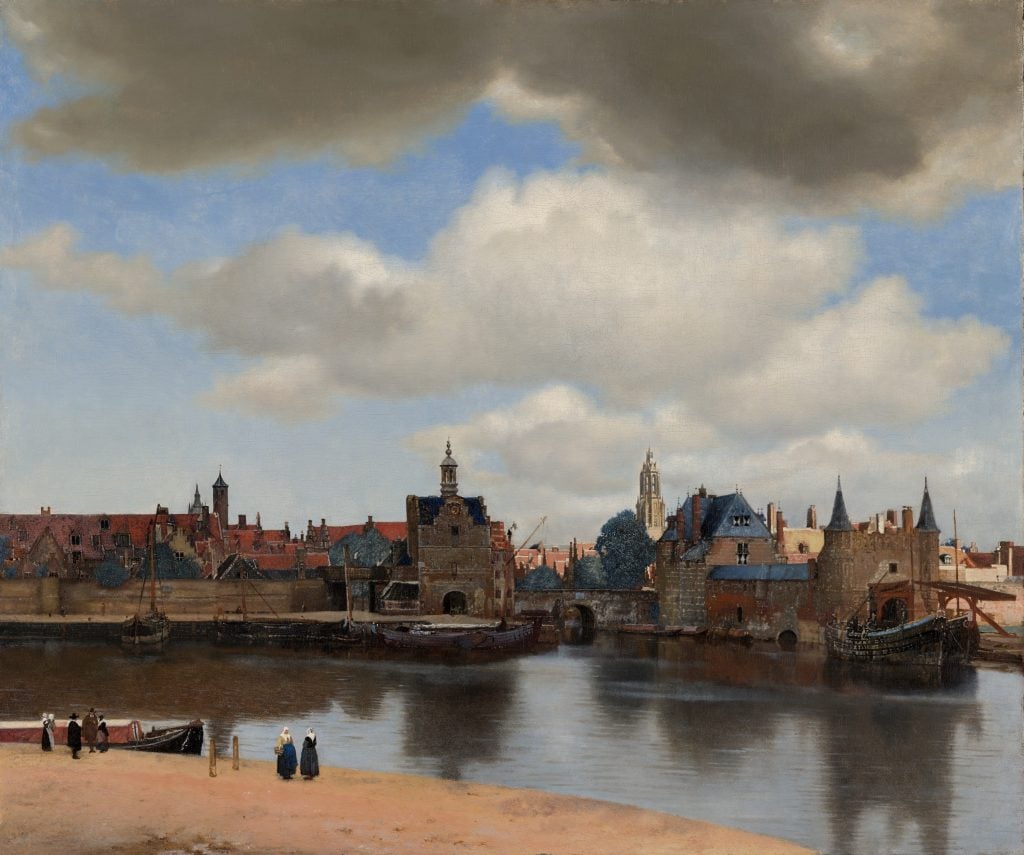
Johannes Vermeer, View of Delft (1660-61), oil on canvas. Mauritshuis, The Hague.
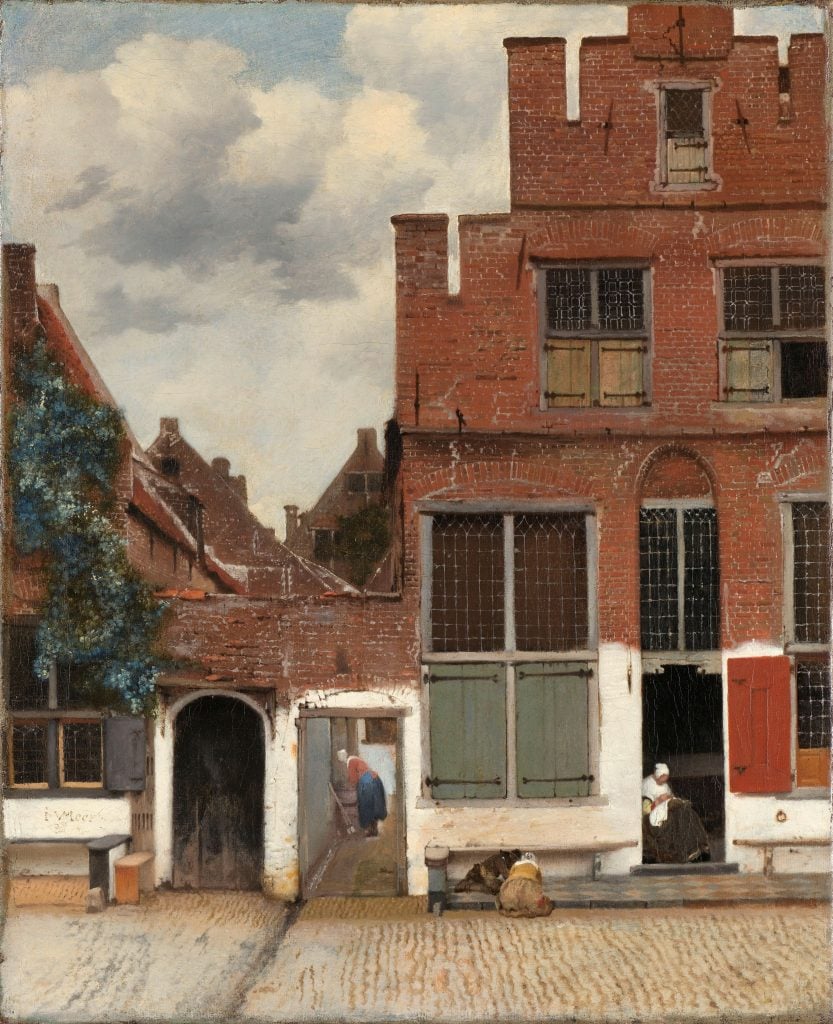
Johannes Vermeer, View of Houses in Delft, also known as The Little Street (1658-59) oil on canvas. Rijksmuseum, Amsterdam. Gift of H.W.A. Deterding, London.
Early Ambitions
This section features four large paintings that are Vermeer’s earliest known works, executed in the artist’s early 20s. Vermeer was born into the times of religious conflicts. A Reformed Protestant by birth, the artist married Catharina Bolnes, a Catholic. The religious themes play a dominant role in works created during this period. The Procuress (1656), however, marks a turning point of Vermeer’s ambition as a painter, as he later chose to focus on capturing everyday life in his works.
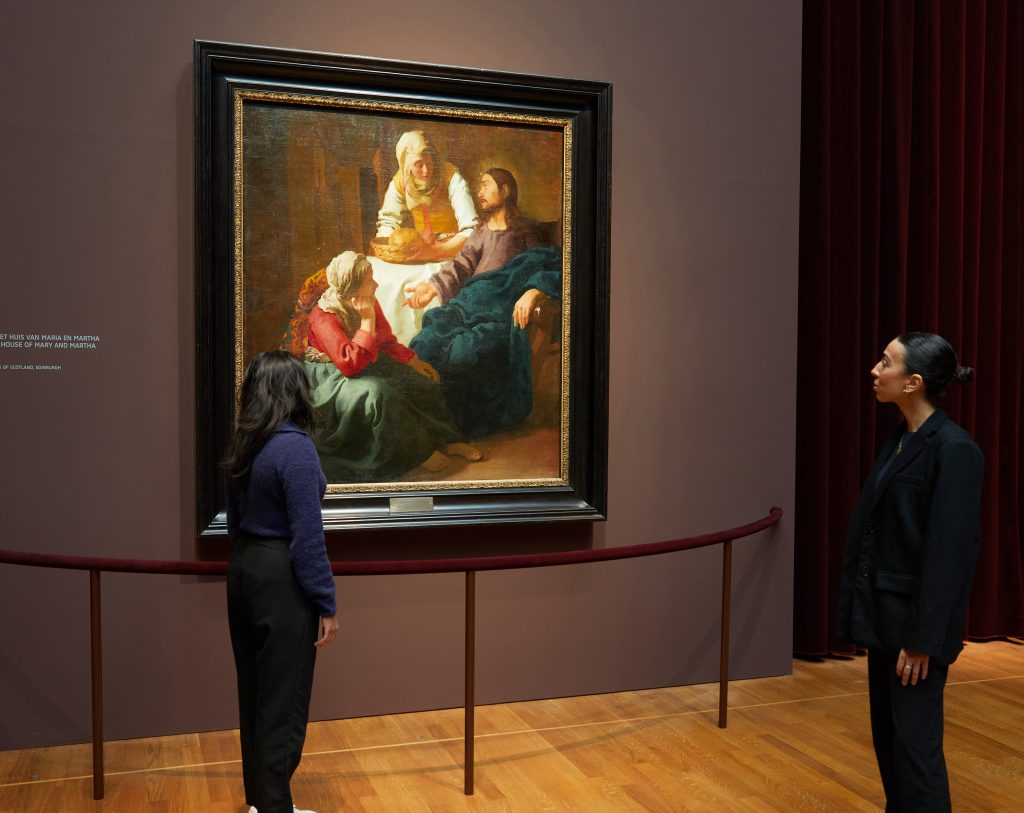
Christ in the House of Mary and Martha, Johannes Vermeer, ca. 1655. National Gallery of Scotland, Edinburgh.

Diana and her Companions, Johannes Vermeer, c. 1653-1654. Mauritshuis, Den Haag.
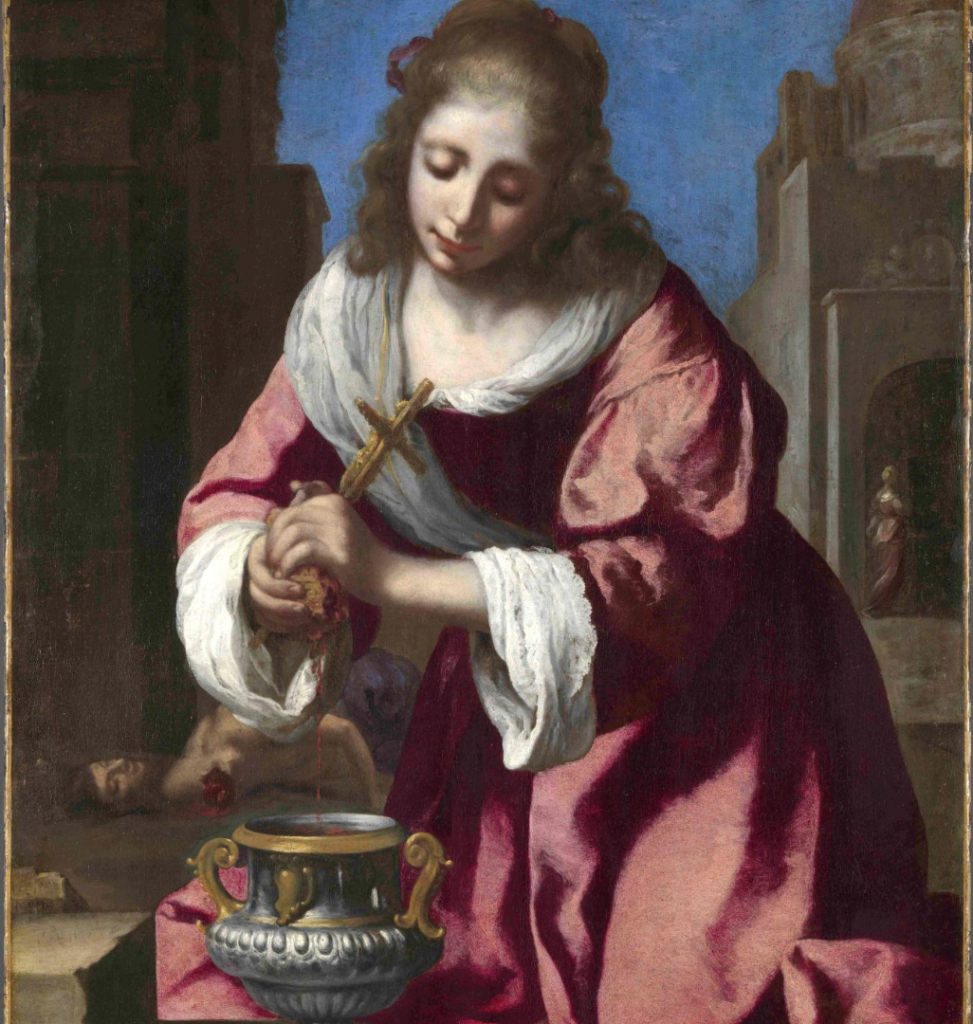
Saint Praxedis, Johannes Vermeer, ca. 1655. National Museum of Western Art, Tokyo.
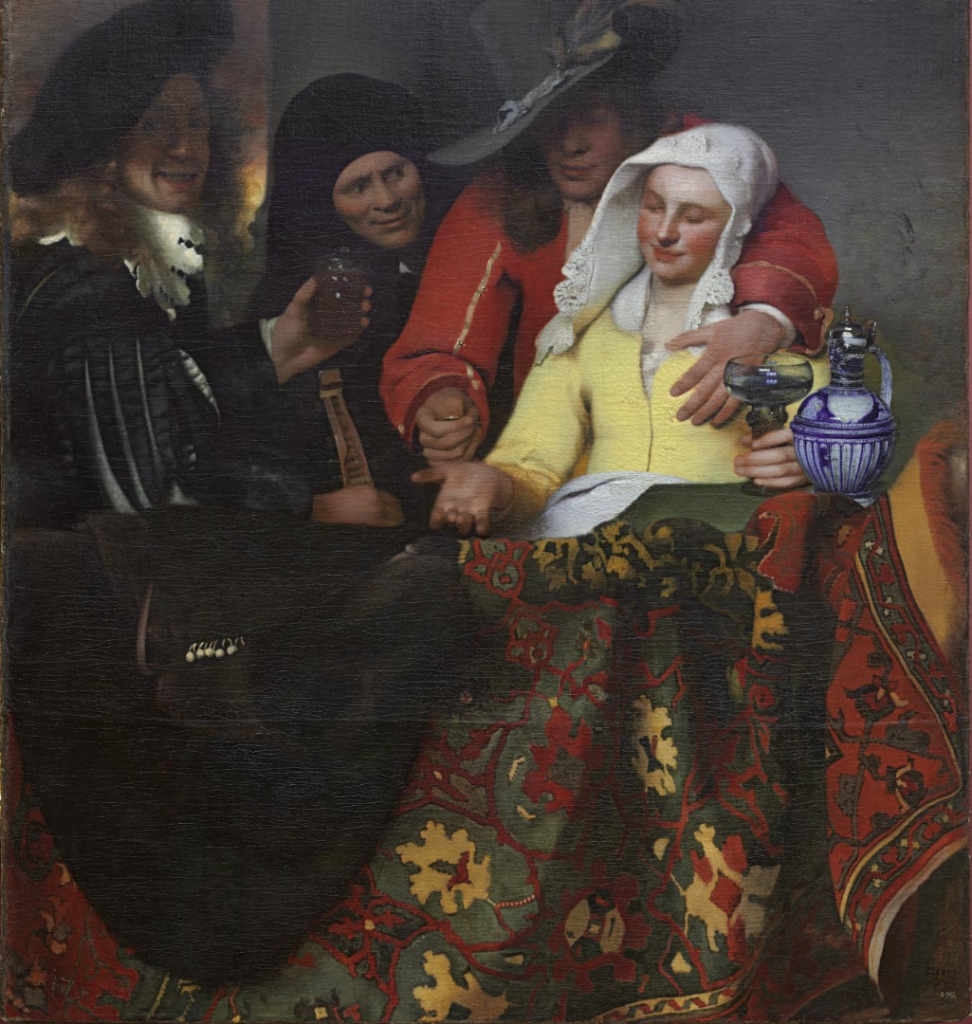
The Procuress, Johannes Vermeer, ca. 1656. Gemäldegalerie Alte Meister, Dresden.
First Interiors
The two paintings featured in this section depict what seems to be the mundane, everyday life, but art historians suggest that these two paintings illustrate how Vermeer mastered his skill in portraying a pictorial space on a flat surface, creating depth and composition with a single vanishing point.
Girl Reading a Letter at an Open Window, Johannes Vermeer, 1657-58, oil on canvas. Gemäldegalerie Alte Meister, Dresden.
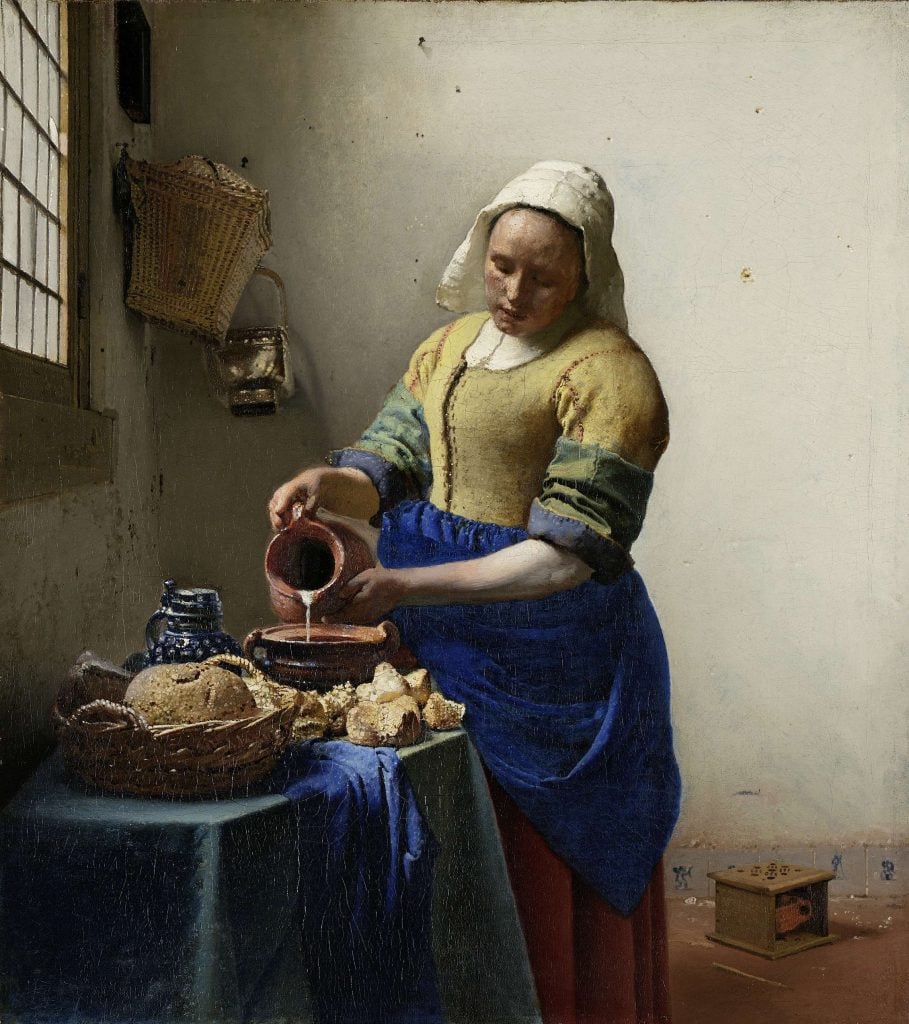
The Milkmaid, Johannes Vermeer, 1658-59, oil on canvas. Rijksmuseum, Amsterdam. Purchased with the support of the Vereniging Rembrandt.
Gazing Out
This section identifies three works related to the windows, exploring how the inner world is connected to that of the outside, by either opening the windows or having someone looking out the window.
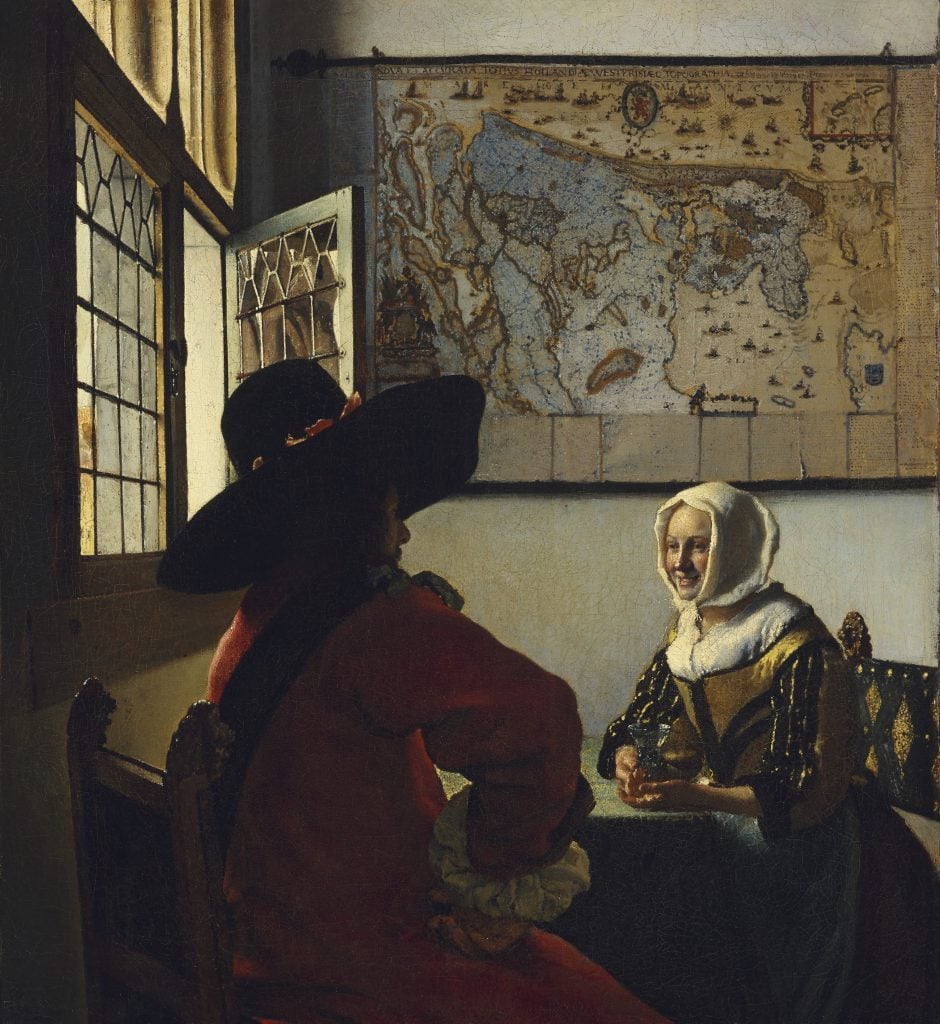
Officer and Laughing Girl, Johannes Vermeer, 1657-58, oil on canvas. The Frick Collection, New York. Photo: Joseph Coscia Jr.
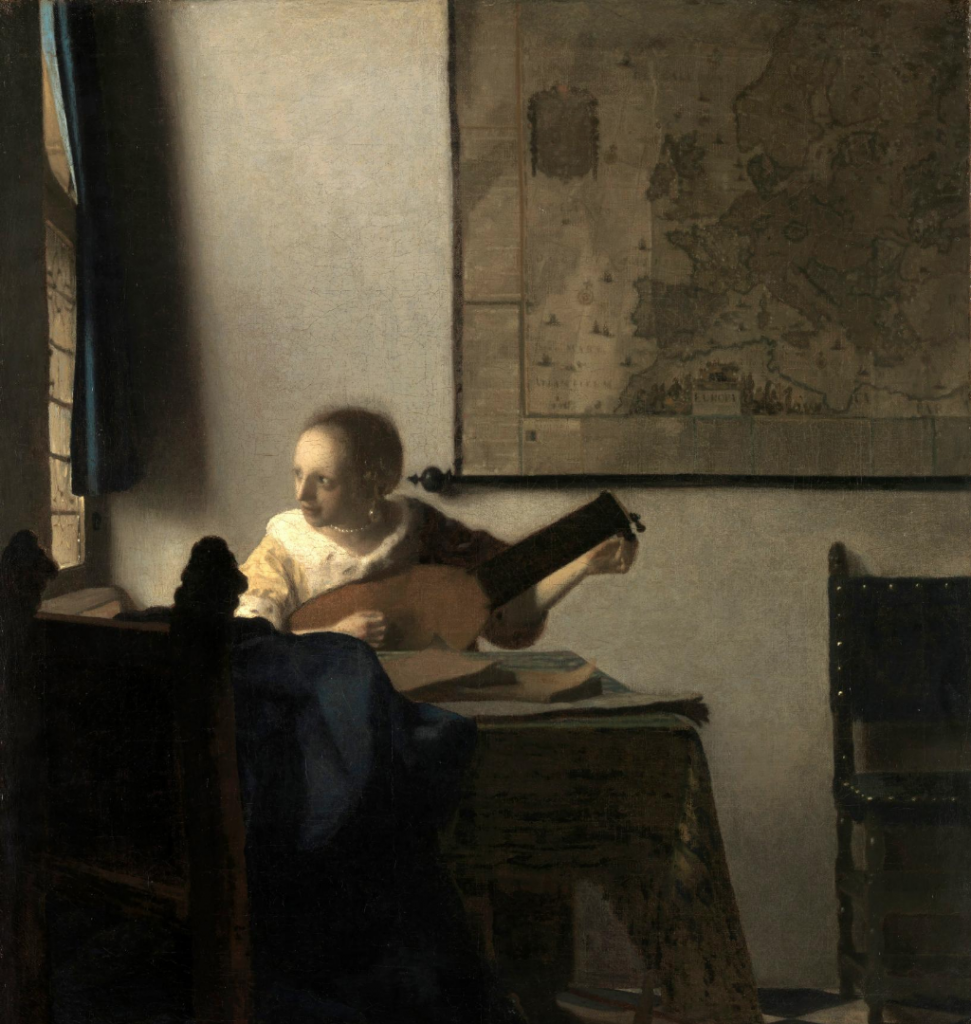
Woman with a Lute, Johannes Vermeer, ca. 1662-63. The Metropolitan Museum of Art, New York City.
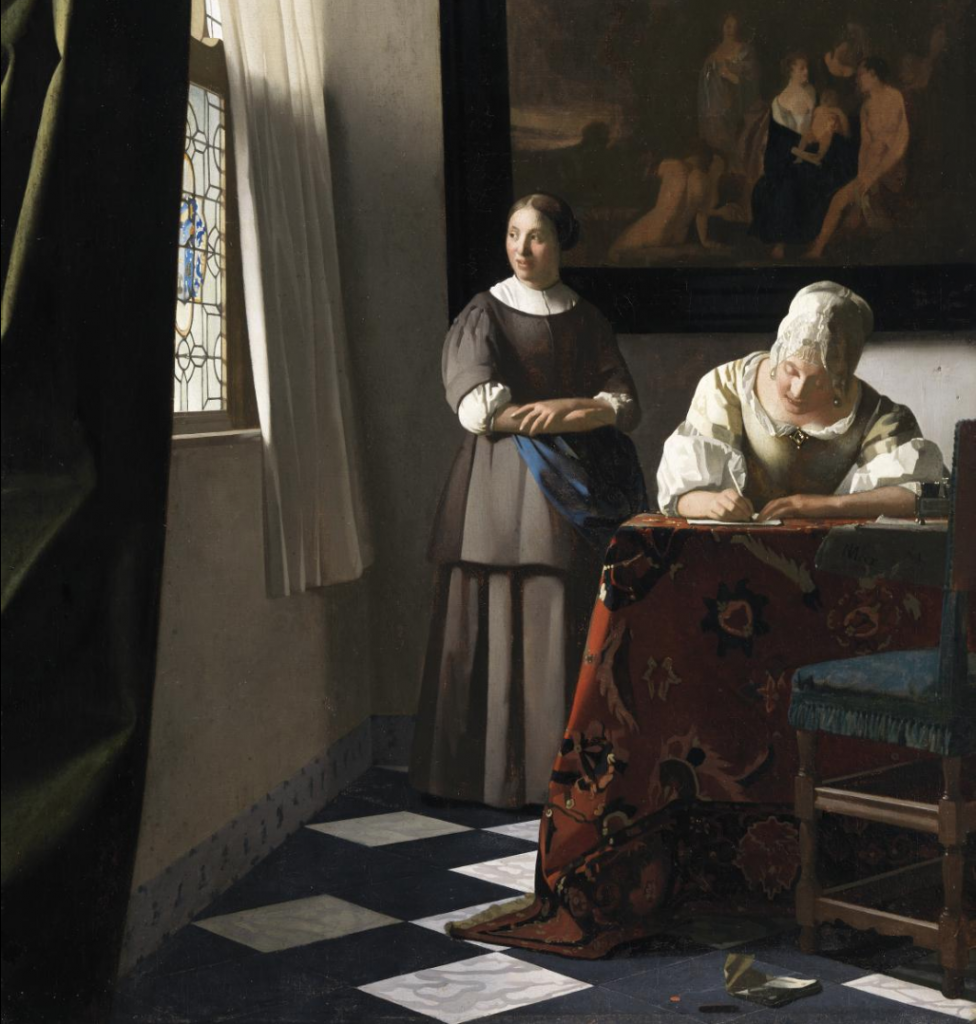
Lady Writing with Her Maid, Johannes Vermeer, ca. 1670-1671. National Gallery of Ireland, Dublin.
Up Close
Is she looking at you or not? This group of paintings depicts women with mysterious gazes. But not everyone of them is engaging with the viewer. The Lacemaker, for example, keeps her head down on her work, but Vermeer brought the viewer so close to her that we can see the threads in her hands.
This section also includes the controversial Girl with a Flute, which has caused a debate on whether it was a genuine work of Vermeer.

Girl with a Flute, Johannes Vermeer, ca. 1669-1675. National Gallery of Art, Washington D.C.
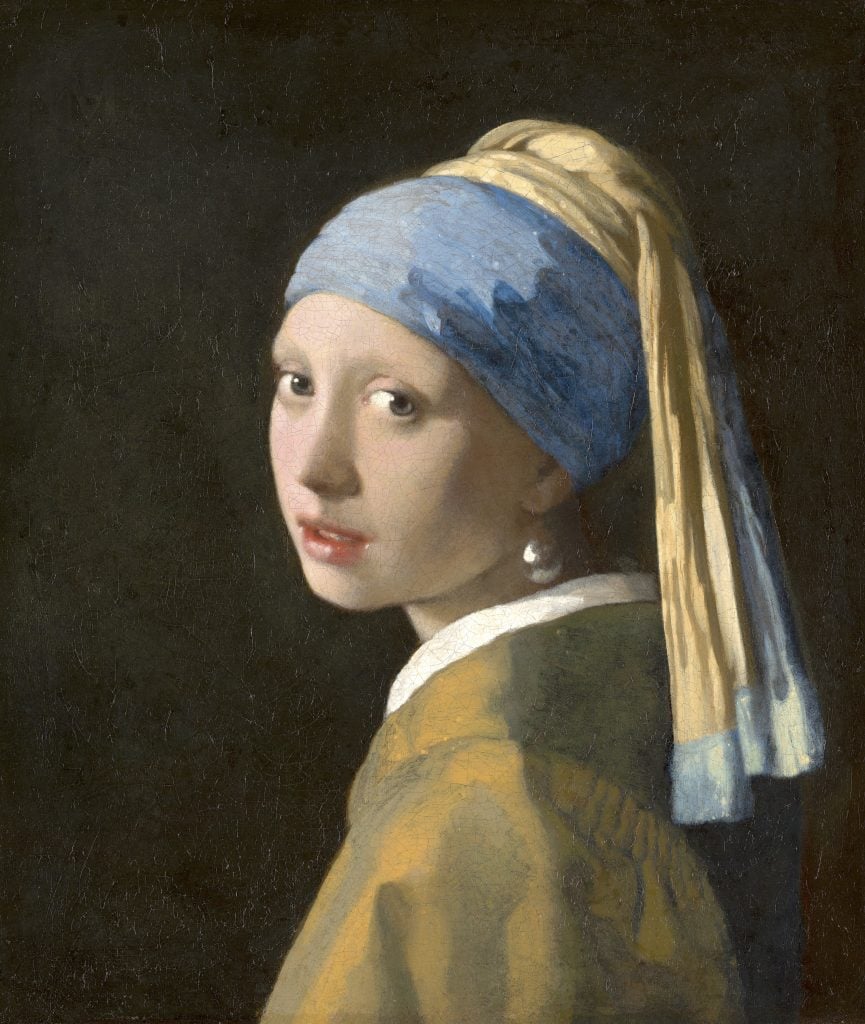
Girl with a Pearl Earring, 1664–67, oil on canvas. Mauritshuis, The Hague. Bequest of Arnoldus Andries des Tombe, The Hague.
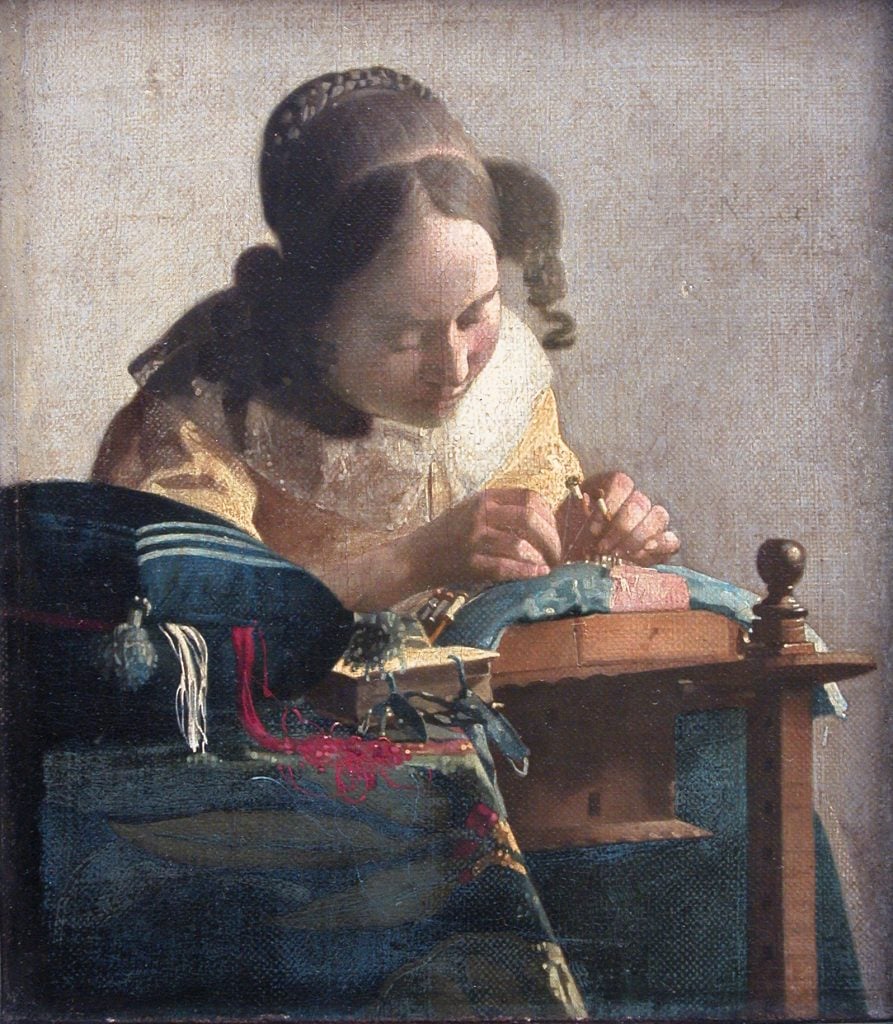
The Lacemaker, Johannes Vermeer, 1666–68, oil on canvas mounted on panel. Musée du Louvre, Paris.
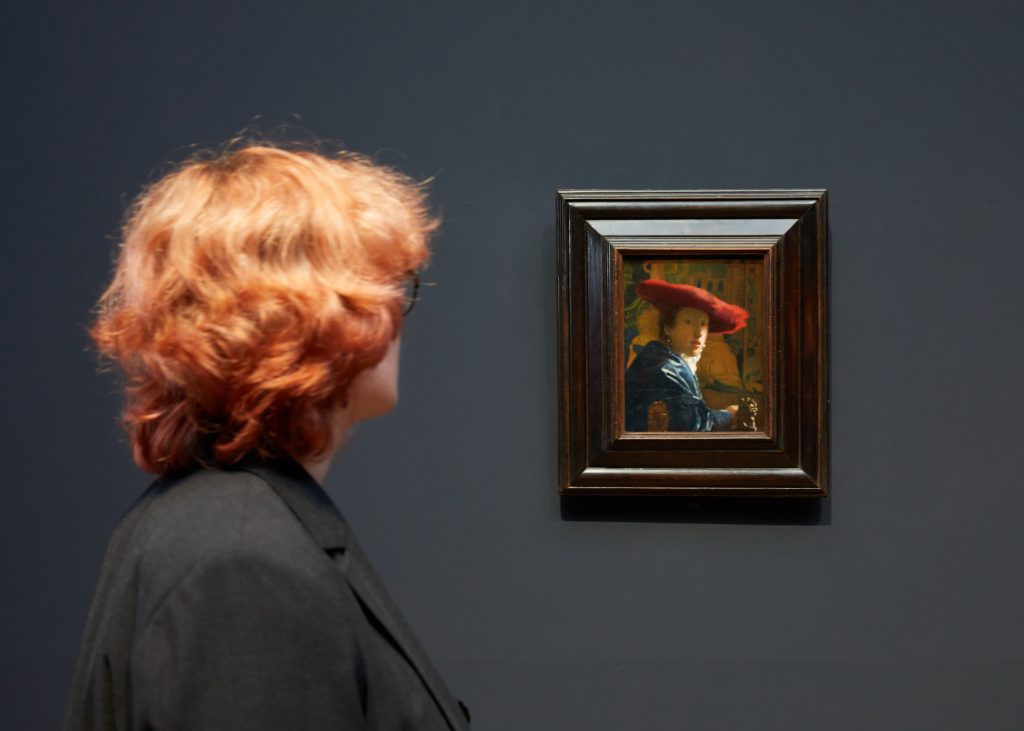
Girl with a Red Hat, Johannes Vermeer, ca. 1665. National Gallery of Art, Washington D.C. ‘Vermeer’ exhibition. Photo Rijksmuseum/ Henk Wildschut.
Musical Appeal
Music has a strong presence in Vermeer’s modest oeuvre, as highlighted in this section. Curiously, the women in both paintings are looking at the viewer, as if their music-making was interrupted.
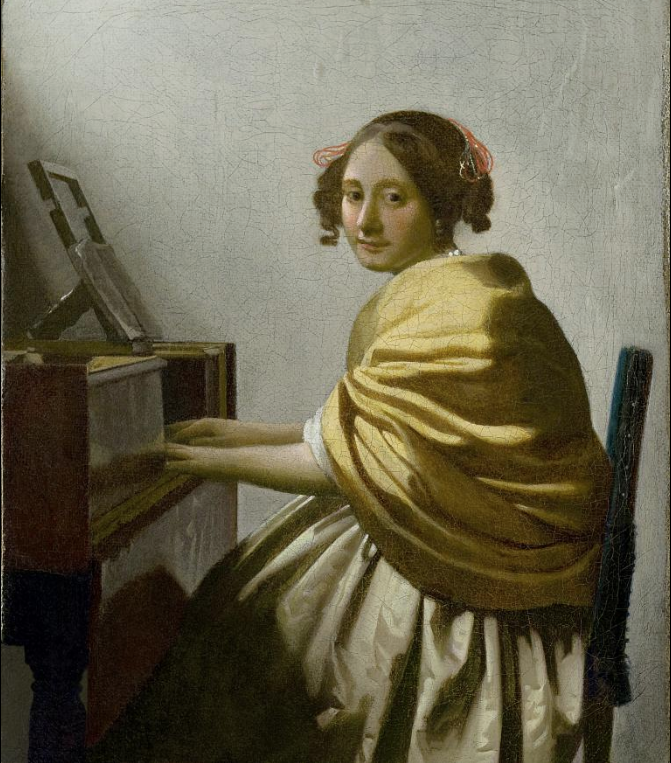
Young Woman Seated at a Virginal, Johannes Vermeer, ca. 1670-1672. Leiden Collection, New York.
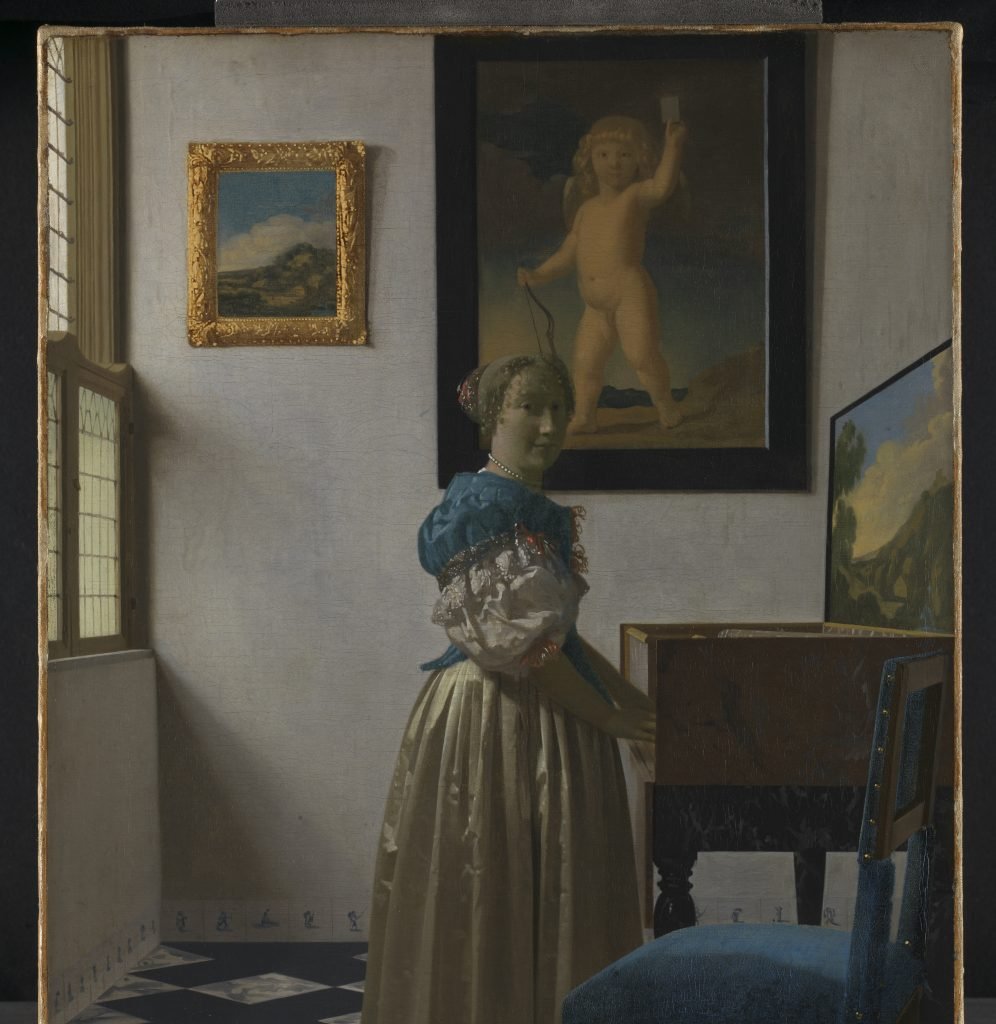
A Young Woman standing at a Virginal, Johannes Vermeer, 1670–72, oil on canvas. The National Gallery, London
Letters From the Outside World
Widely seen as one of the most intriguing paintings by Vermeer, The Love Letter maintains a distance between the two women and the viewer, who is positioned as if taking a peep from an adjacent room. The women’s subtle yet dramatic facial expressions against the backdrop of the painting of the seascape on the wall, suggest a story behind the letter in the hands of the lady in the yellow robe.
Besides music, letters like a supporting character in Vermeer’s paintings. Characters are often depicted writing, reading, or receiving letters, suggesting life beyond the painting.
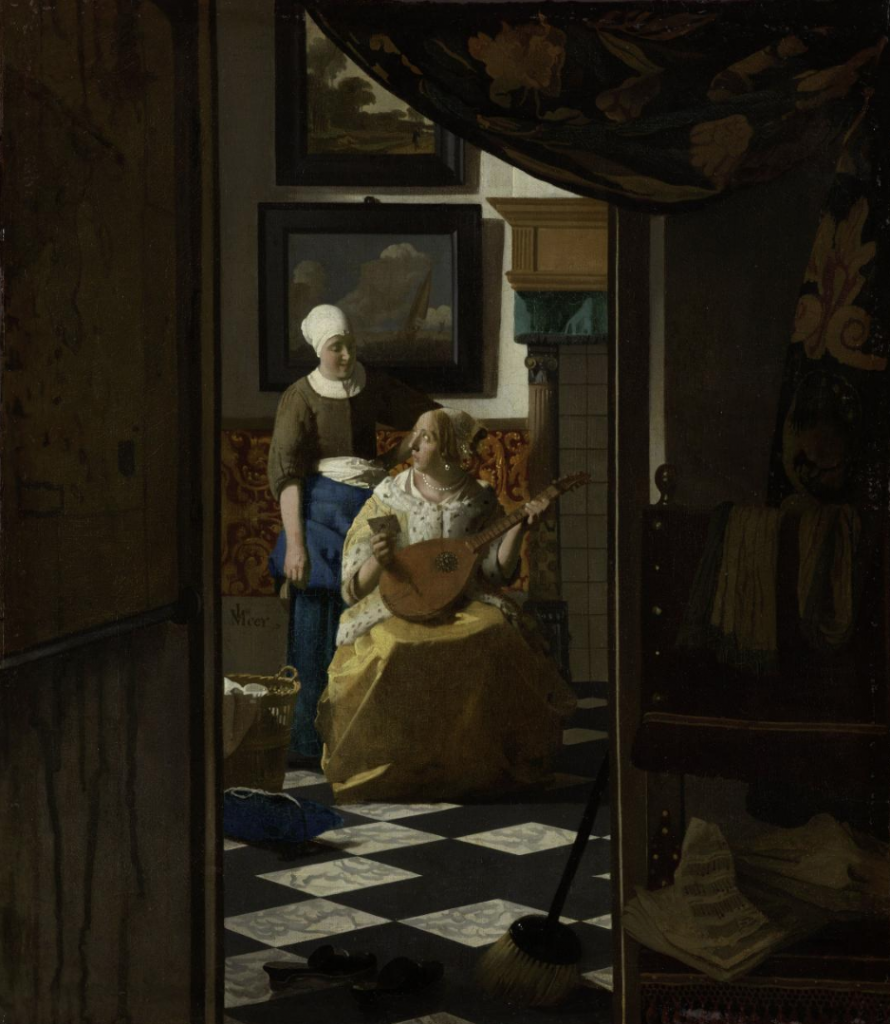
The Love Letter, Johannes Vermeer, ca. 1669 – ca. 1670. Rijksmuseum, Amsterdam.

Woman in Blue Reading a Letter, Johannes Vermeer, 1662-64, oil on canvas. Rijksmuseum, Amsterdam. On loan from the City of Amsterdam (A. van der Hoop Bequest).
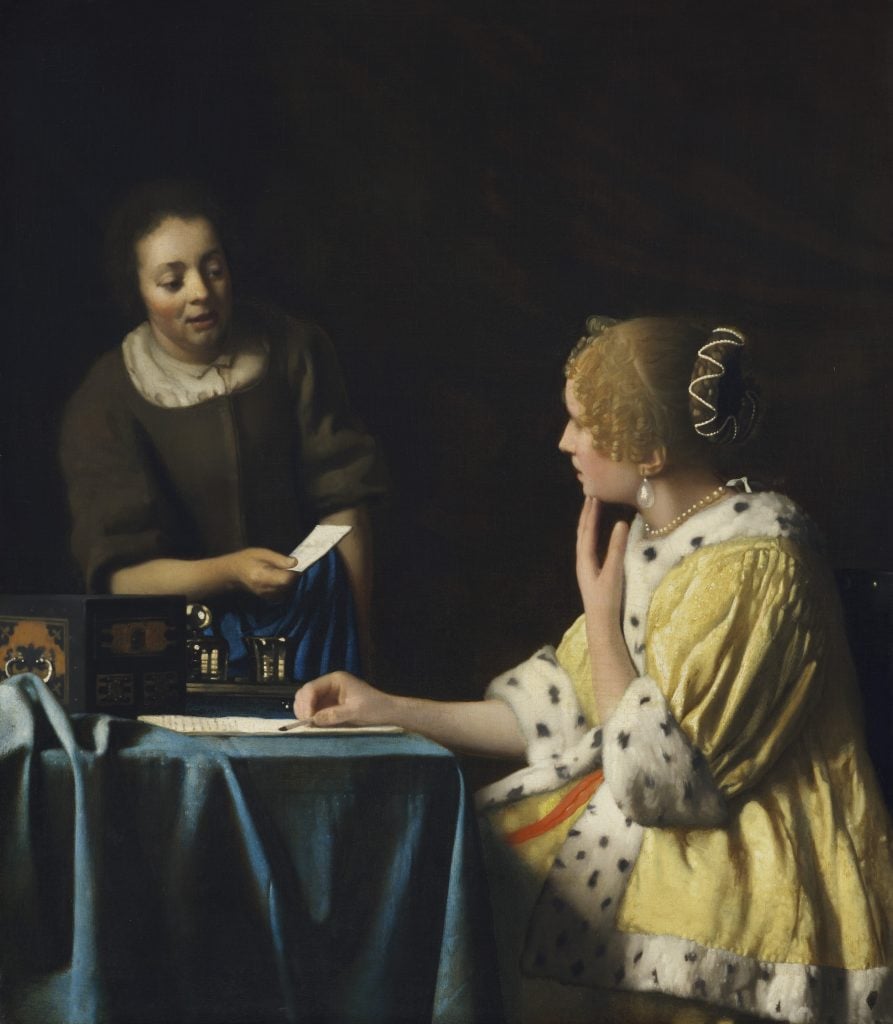
Mistress and Maid, Johannes Vermeer, c. 1665-67, oil on canvas. The Frick Collection, New York. Photo: Joseph Coscia Jr.
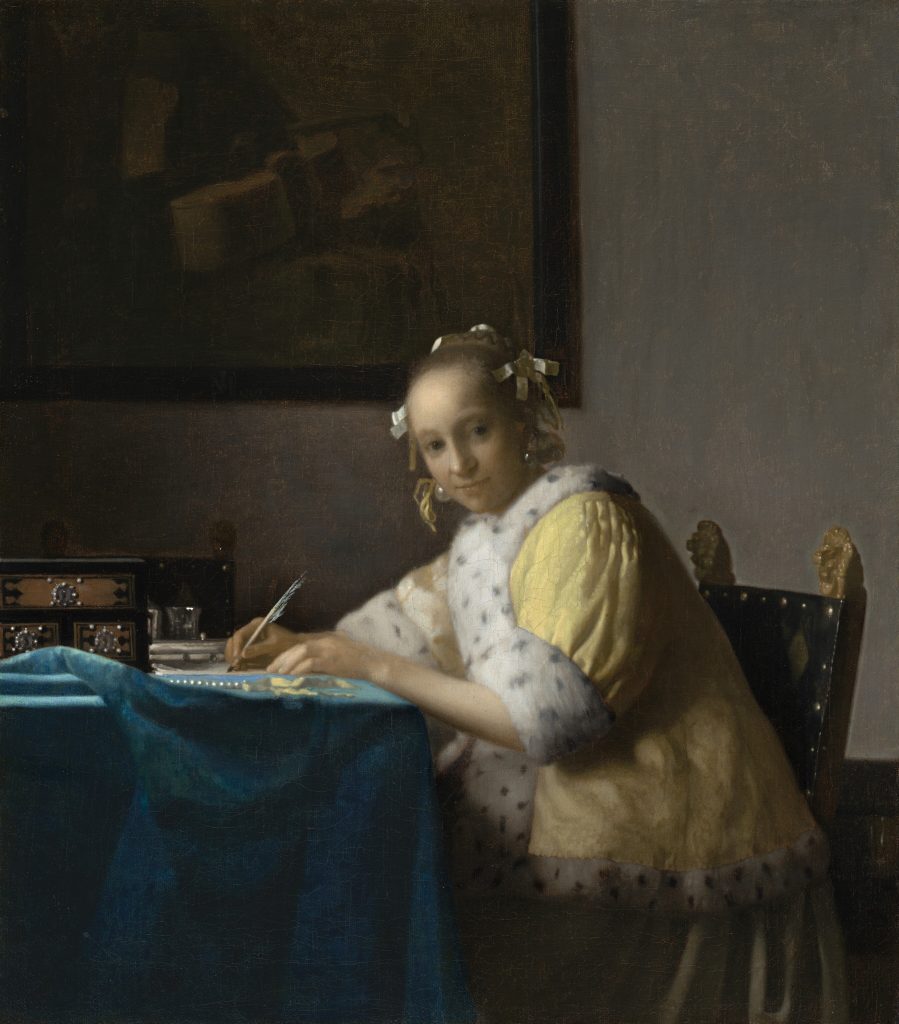
A Lady Writing, Johannes Vermeer, 1664-67, oil on canvas. National Gallery of Art, Washington. Gift of Harry Waldron Havemeyer and Horace Havemeyer Jr., in memory of their father, Horace Havemeyer
Gentlemen Callers
The gentlemen in Vermeer’s paintings have a curious role to play, as seen in these two paintings below. Still donning a cloak or a cape, these men appear to have just entered the room from the outside, interrupting whatever the women are doing, whether playing the music or taking a sip of wine.
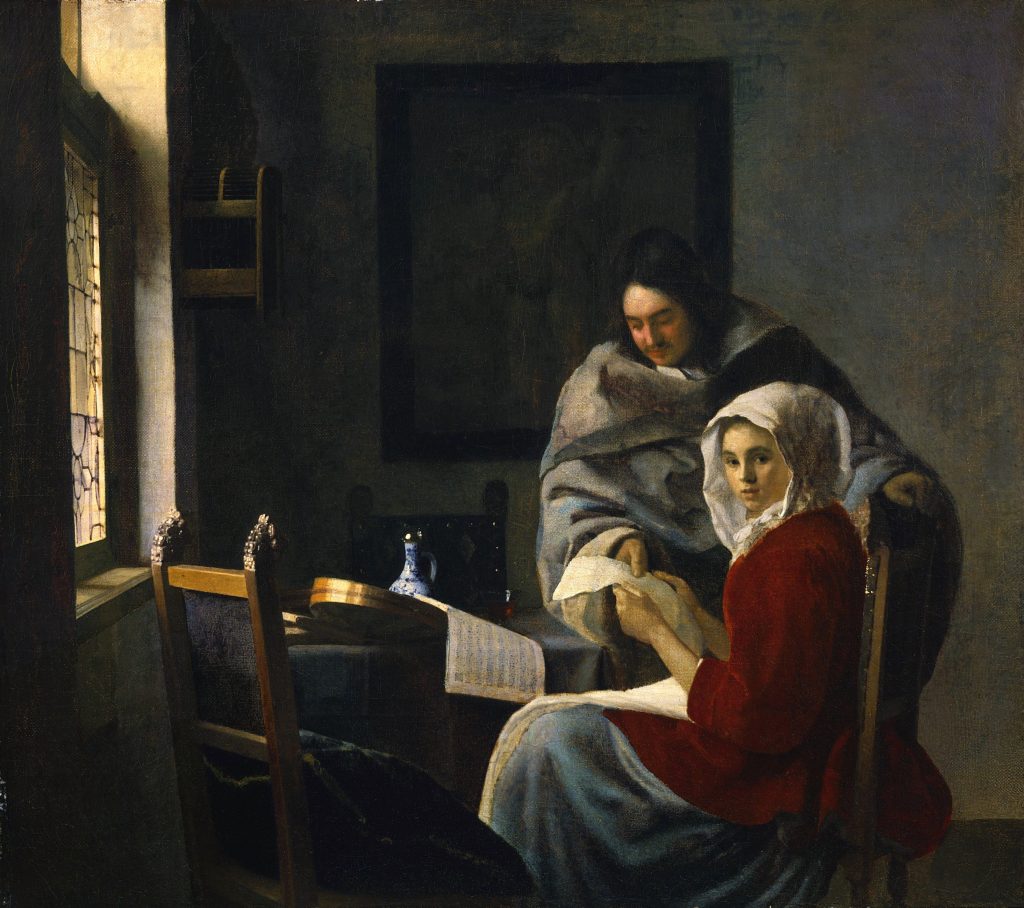
Girl Interrupted at Her Music, Johannes Vermeer,. 1659–61, oil on canvas. The Frick Collection. New York. Photo: Joseph Coscia Jr
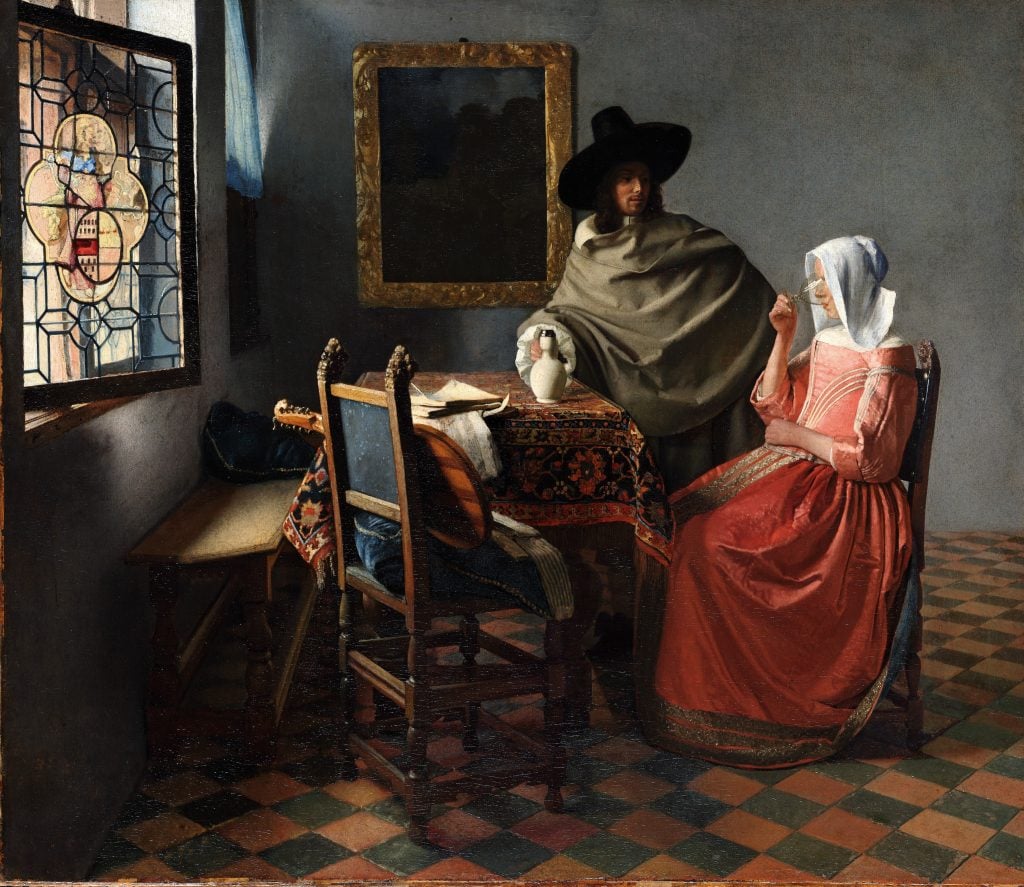
The Glass of Wine, Johannes Vermeer, c. 1659-61, oil on canvas. Staatliche Museen zu Berlin – Gemäldegalerie
View of the World
Science is a key subject in Vermeer’s paintings, as seen in The Geographer. Another similar one is The Astronomer, which is in the collection of Louvre but not in this show in Amsterdam. Maps frequently recur.
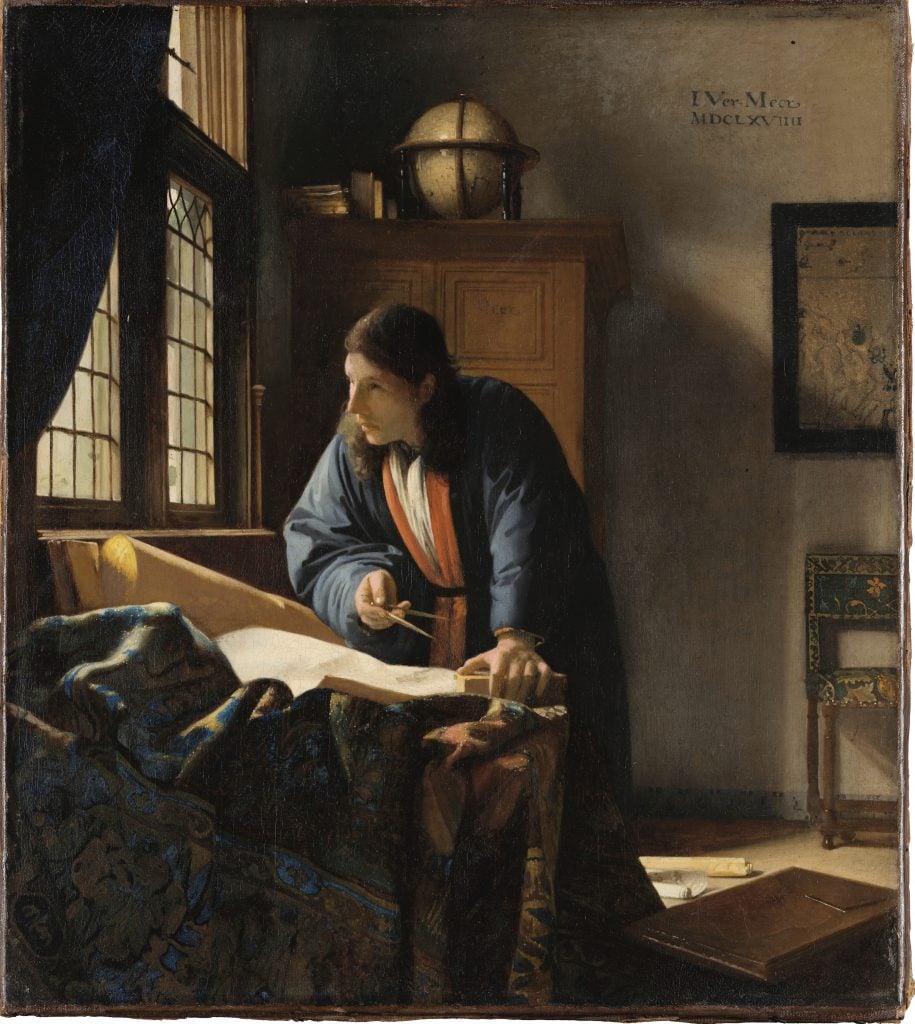
The Geographer, Johannes Vermeer, 1669, oil on canvas. Städel Museum, Frankfurt am Main
Reflecting on Vanity and Faith
This last section of the exhibition looks into the symbols presented in three particular paintings that may suggest Vermeer’s views of the world he lived in the, and the reflection of his inner struggles in relation to his faith and monetary values.
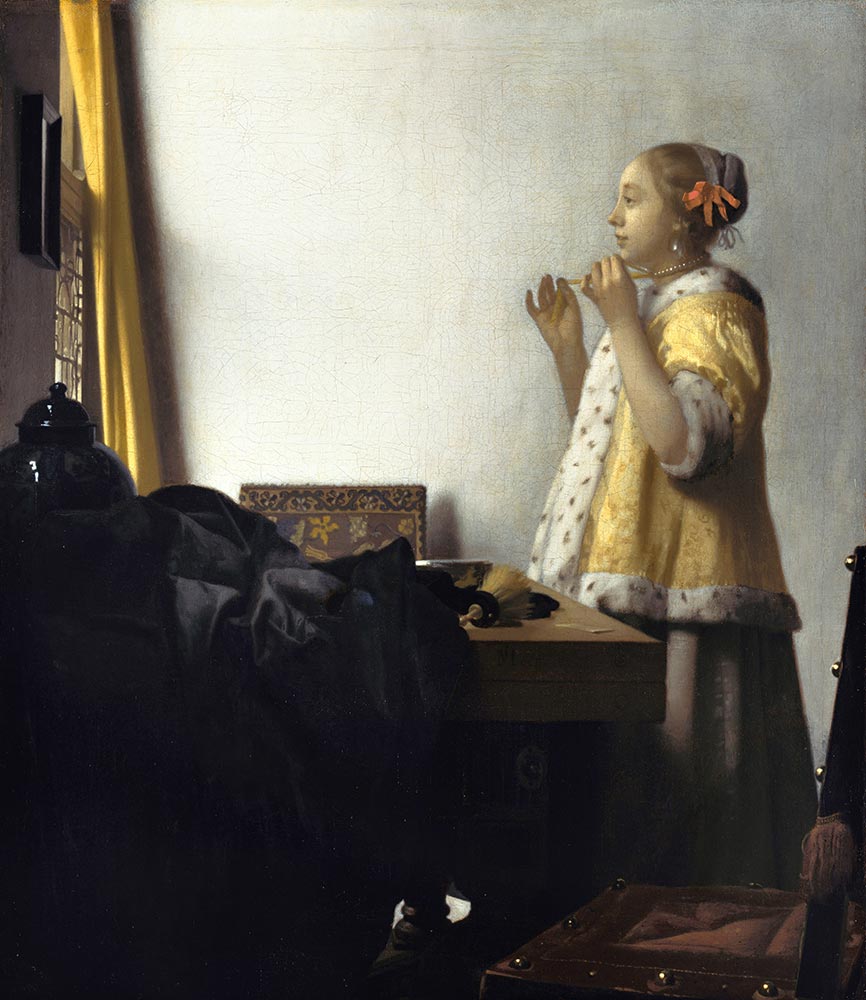
Woman with a Pearl Necklace, Johannes Vermeer, (c. 1662-64), oil on canvas. Staatliche Museen zu Berlin – Gemäldegalerie.
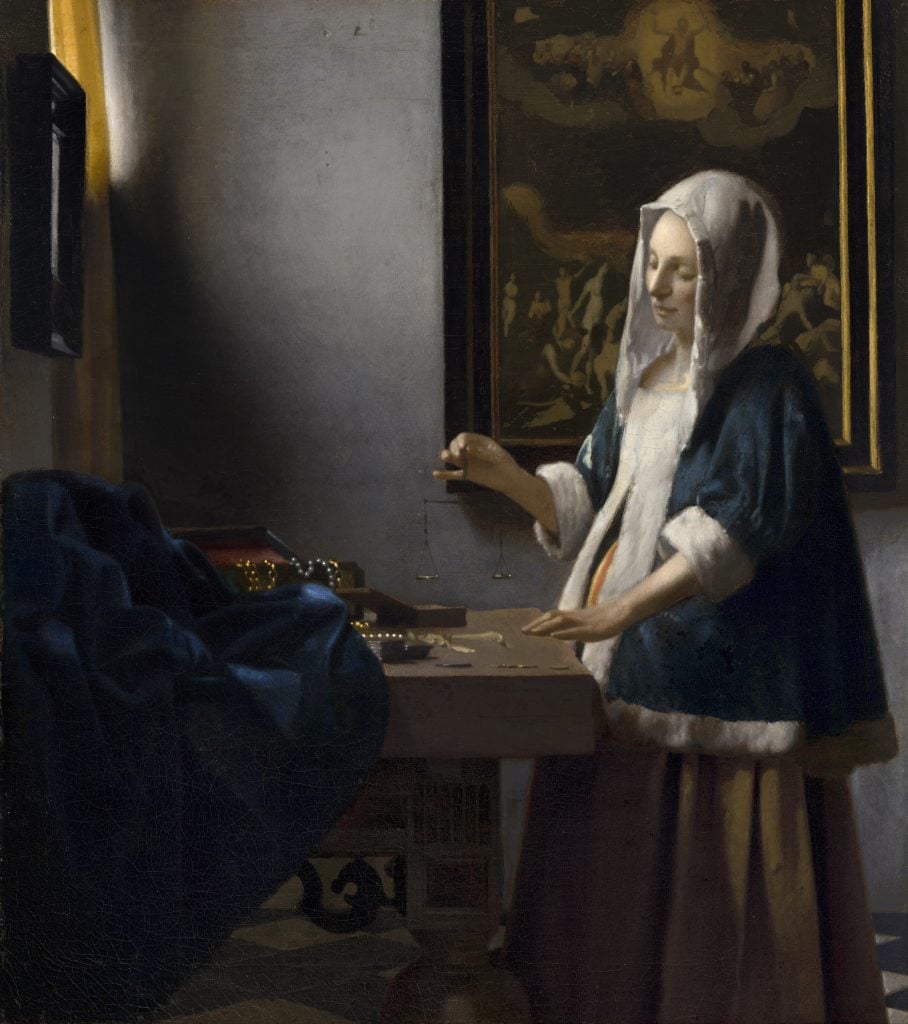
Woman Holding a Balance, Johannes Vermeer, c. 1662-64, oil on canvas. National Gallery of Art, Washington, Widener Collection
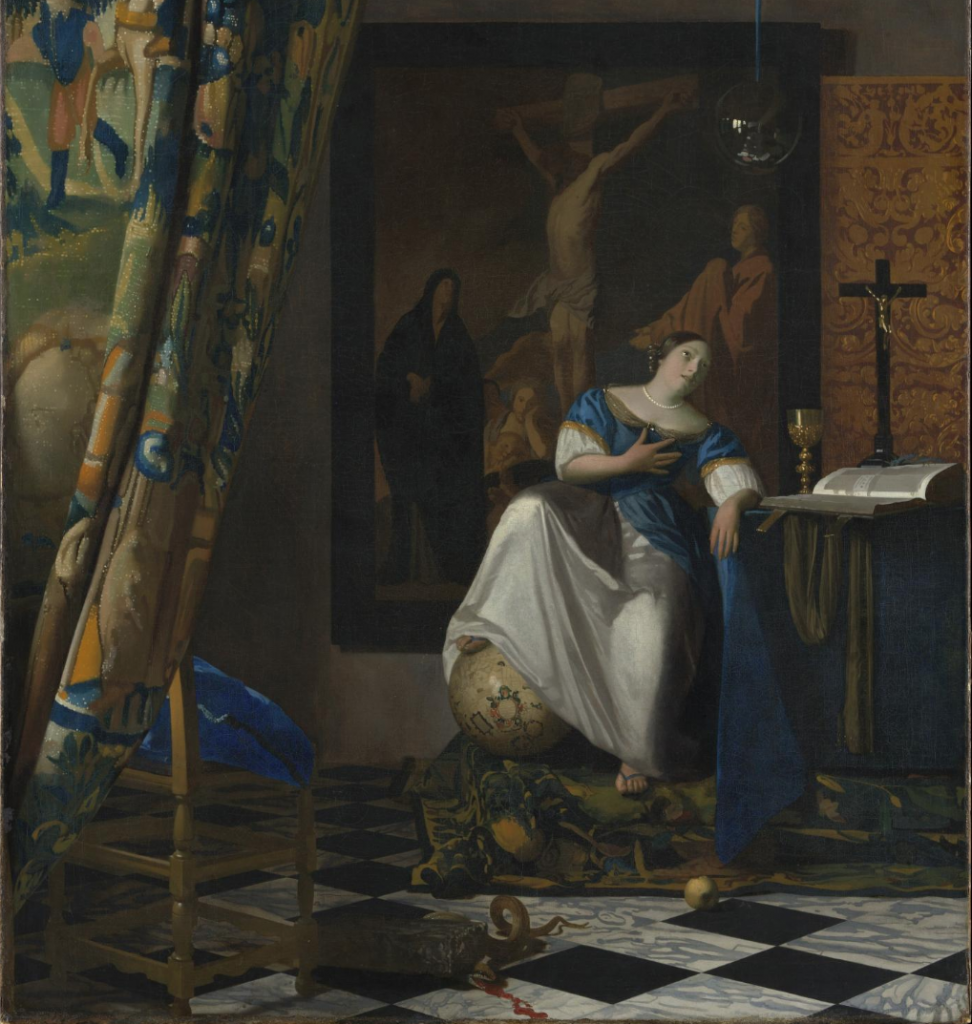
Allegory of Faith, Johannes Vermeer, ca. 1670-1674. Metropolitan Museum of Art, New York
More Trending Stories:
Whoops! A Clumsy Art Fair Visitor Shattered a $42,000 Jeff Koons Balloon Dog Sculpture in Miami
Follow Artnet News on Facebook:
Want to stay ahead of the art world? Subscribe to our newsletter to get the breaking news, eye-opening interviews, and incisive critical takes that drive the conversation forward.
Art
Calvin Lucyshyn: Vancouver Island Art Dealer Faces Fraud Charges After Police Seize Millions in Artwork

In a case that has sent shockwaves through the Vancouver Island art community, a local art dealer has been charged with one count of fraud over $5,000. Calvin Lucyshyn, the former operator of the now-closed Winchester Galleries in Oak Bay, faces the charge after police seized hundreds of artworks, valued in the tens of millions of dollars, from various storage sites in the Greater Victoria area.
Alleged Fraud Scheme
Police allege that Lucyshyn had been taking valuable art from members of the public under the guise of appraising or consigning the pieces for sale, only to cut off all communication with the owners. This investigation began in April 2022, when police received a complaint from an individual who had provided four paintings to Lucyshyn, including three works by renowned British Columbia artist Emily Carr, and had not received any updates on their sale.
Further investigation by the Saanich Police Department revealed that this was not an isolated incident. Detectives found other alleged victims who had similar experiences with Winchester Galleries, leading police to execute search warrants at three separate storage locations across Greater Victoria.
Massive Seizure of Artworks
In what has become one of the largest art fraud investigations in recent Canadian history, authorities seized approximately 1,100 pieces of art, including more than 600 pieces from a storage site in Saanich, over 300 in Langford, and more than 100 in Oak Bay. Some of the more valuable pieces, according to police, were estimated to be worth $85,000 each.
Lucyshyn was arrested on April 21, 2022, but was later released from custody. In May 2024, a fraud charge was formally laid against him.
Artwork Returned, but Some Remain Unclaimed
In a statement released on Monday, the Saanich Police Department confirmed that 1,050 of the seized artworks have been returned to their rightful owners. However, several pieces remain unclaimed, and police continue their efforts to track down the owners of these works.
Court Proceedings Ongoing
The criminal charge against Lucyshyn has not yet been tested in court, and he has publicly stated his intention to defend himself against any pending allegations. His next court appearance is scheduled for September 10, 2024.
Impact on the Local Art Community
The news of Lucyshyn’s alleged fraud has deeply affected Vancouver Island’s art community, particularly collectors, galleries, and artists who may have been impacted by the gallery’s operations. With high-value pieces from artists like Emily Carr involved, the case underscores the vulnerabilities that can exist in art transactions.
For many art collectors, the investigation has raised concerns about the potential for fraud in the art world, particularly when it comes to dealing with private galleries and dealers. The seizure of such a vast collection of artworks has also led to questions about the management and oversight of valuable art pieces, as well as the importance of transparency and trust in the industry.
As the case continues to unfold in court, it will likely serve as a cautionary tale for collectors and galleries alike, highlighting the need for due diligence in the sale and appraisal of high-value artworks.
While much of the seized artwork has been returned, the full scale of the alleged fraud is still being unraveled. Lucyshyn’s upcoming court appearances will be closely watched, not only by the legal community but also by the wider art world, as it navigates the fallout from one of Canada’s most significant art fraud cases in recent memory.
Art collectors and individuals who believe they may have been affected by this case are encouraged to contact the Saanich Police Department to inquire about any unclaimed pieces. Additionally, the case serves as a reminder for anyone involved in high-value art transactions to work with reputable dealers and to keep thorough documentation of all transactions.
As with any investment, whether in art or other ventures, it is crucial to be cautious and informed. Art fraud can devastate personal collections and finances, but by taking steps to verify authenticity, provenance, and the reputation of dealers, collectors can help safeguard their valuable pieces.
Art
Ukrainian sells art in Essex while stuck in a warzone – BBC.com
[unable to retrieve full-text content]
Ukrainian sells art in Essex while stuck in a warzone BBC.com

Source link
Art
Somerset House Fire: Courtauld Gallery Reopens, Rest of Landmark Closed
The Courtauld Gallery at Somerset House has reopened its doors to the public after a fire swept through the historic building in central London. While the gallery has resumed operations, the rest of the iconic site remains closed “until further notice.”
On Saturday, approximately 125 firefighters were called to the scene to battle the blaze, which sent smoke billowing across the city. Fortunately, the fire occurred in a part of the building not housing valuable artworks, and no injuries were reported. Authorities are still investigating the cause of the fire.
Despite the disruption, art lovers queued outside the gallery before it reopened at 10:00 BST on Sunday. One visitor expressed his relief, saying, “I was sad to see the fire, but I’m relieved the art is safe.”
The Clark family, visiting London from Washington state, USA, had a unique perspective on the incident. While sightseeing on the London Eye, they watched as firefighters tackled the flames. Paul Clark, accompanied by his wife Jiorgia and their four children, shared their concern for the safety of the artwork inside Somerset House. “It was sad to see,” Mr. Clark told the BBC. As a fan of Vincent Van Gogh, he was particularly relieved to learn that the painter’s famous Self-Portrait with Bandaged Ear had not been affected by the fire.
Blaze in the West Wing
The fire broke out around midday on Saturday in the west wing of Somerset House, a section of the building primarily used for offices and storage. Jonathan Reekie, director of Somerset House Trust, assured the public that “no valuable artefacts or artworks” were located in that part of the building. By Sunday, fire engines were still stationed outside as investigations into the fire’s origin continued.
About Somerset House
Located on the Strand in central London, Somerset House is a prominent arts venue with a rich history dating back to the Georgian era. Built on the site of a former Tudor palace, the complex is known for its iconic courtyard and is home to the Courtauld Gallery. The gallery houses a prestigious collection from the Samuel Courtauld Trust, showcasing masterpieces from the Middle Ages to the 20th century. Among the notable works are pieces by impressionist legends such as Edouard Manet, Claude Monet, Paul Cézanne, and Vincent Van Gogh.
Somerset House regularly hosts cultural exhibitions and public events, including its popular winter ice skating sessions in the courtyard. However, for now, the venue remains partially closed as authorities ensure the safety of the site following the fire.
Art lovers and the Somerset House community can take solace in knowing that the invaluable collection remains unharmed, and the Courtauld Gallery continues to welcome visitors, offering a reprieve amid the disruption.
-

 Sports9 hours ago
Sports9 hours agoArmstrong scores, surging Vancouver Whitecaps beat slumping San Jose Earthquakes 2-0
-

 News9 hours ago
News9 hours agoAs plant-based milk becomes more popular, brands look for new ways to compete
-

 News6 hours ago
News6 hours agoLooking for the next mystery bestseller? This crime bookstore can solve the case
-

 News6 hours ago
News6 hours agoLabour Minister praises Air Canada, pilots union for avoiding disruptive strike
-

 News16 hours ago
News16 hours agoCF Montreal finds its groove with 2-1 win over Charlotte
-

 News16 hours ago
News16 hours agoToronto FC downs Austin FC to pick up three much-needed points in MLS playoff push
-

 News9 hours ago
News9 hours agoInflation expected to ease to 2.1%, lowest level since March 2021: economists
-

 News9 hours ago
News9 hours agoLiberal candidate in Montreal byelection says campaign is about her — not Trudeau


















